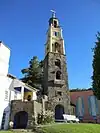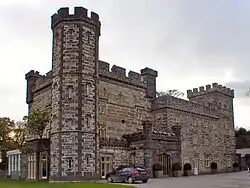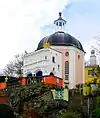List of buildings and structures in Portmeirion
This is a list of notable buildings and structures in the village of Portmeirion, in Gwynedd, northwest Wales. Portmeirion was created as an Italianate village by the architect, Clough Williams-Ellis, who bought the Aber Iâ mansion and its estate in 1925 as the location for his project. He built his eccentric, eclectic village between 1925 and 1975.[1] He also bought the nearby Castell Deudraeth in 1931.
Allegedly inspired by the colourful buildings of Portofino in Italy, many of Portmeirion's buildings were built on a tight budget, using salvaged and re-used materials.[2] In 1971 fourty of the fifty main buildings gained a Grade II heritage listing, one of the first examples of this happening for a still living architect.[3]
The village is now a tourist destination with over 200,000 visitors a year.[1]
Listed buildings
| Image | Name | Date completed | Description | Listing |
|---|---|---|---|---|
.jpg.webp) |
Portmeirion Town Hall (Hercules Hall) | 1938 | An imposing two-storey building in a 17th-century style, the Town Hall incorporates large amounts of dressed stone and a vaulted plasterwork ceiling salvaged from Emral Hall in Flintshire. These were bought at auction by Williams-Ellis. The vaulted ceiling depicts the Labours of Hercules (as well as the signs of the Zodiac) which give the building its alternative name of Hercules Hall.[4] | Grade I |
 |
Campanile (Bell Tower) |
1928 | Described as the most significant building in the village, the tower is seven storeys in height, construction began in 1925 with the intention of it being a focal point.[5] The tower is in a Baroque style, incorporating stone from a nearby 12th-century castle and a chiming clock from a London brewery.[6] | Grade II* |
 |
The Colonnade | 1959 (original c. 1760) |
Originally a bath stone colonnade, part of the Arnos Court bathhouse in Bristol dating from circa 1760. The bathhouse was damaged during World War II, Williams-Ellis acquired the Colonnade and erected it in Portmeirion. A portrait head of Williams-Ellis was added by sculptor Jonah Jones.[7] | Grade II* |
 |
Anchor | 1936 | Four storey 'Mediterranean' style building, though tucked into a cliff and accessed from the road at the top floor.[8] Attached to (and forms a pair with) Fountain (1937). Fountain is the yellow building in the picture. | Grade II |
.jpg.webp) |
Angel | 1926 | [9] | Grade II |
 |
The Arches | 1964 | Originally staff accommodation and garages, it became a shop in 1965.[10] | Grade II |
 |
Bandstand and Hercules Steps | 1961 | A single storey classical loggia, though originally designed to house the village electricity substation underneath. Three flights of broad stone steps adjacent.[11] | Grade II |
.jpg.webp) |
Battery | 1927 | A three-storey house with Kent vernacular weatherboarding to the facade. Originally called 'Block C', the ground floor was originally used as a garage.[12] | Grade II |
 |
The Belvedere | 1960 | A simple classical 2-storey house, which incorporates stained glass from Castell Deudraeth.[13] | Grade II |
 |
Bridge House | 1959 | One of the gatehouses to Portmeirion, a two-storey building over a tunnel arch.[14] | Grade II |
.jpg.webp) |
Casino | 1926 | Listed together with the Amis Reunis boat, the Casino loggia is part of the seafront terrace in front of the Portmeirion Hotel.[15] | Grade II |
 |
Castell Deudraeth | 1700s | A mansion on the Portmeirion Estate, bought by Clough Williams-Ellis in 1931. Reopened after extensive renovation in 2001.[16] | Grade II |
.jpg.webp) |
Chantry | 1937 | [17] | Grade II |
.jpg.webp) |
Chantry Lodge | 1969 | Built as an office and reception building.[18] | Grade II |
.jpg.webp) |
Chantry Row | 1963 | [19] | Grade II |
 |
Chinese Gateway and steps | 1961 | A single storey pavilion in a Chinese style with an 'oriental' metal roof. Attached walls, railings and flight of stairs are also listed.[20] | Grade II |
 |
Cliff House | 1969 | A Georgian style house to the east of the village, with facades of three bays.[21] Williams-Ellis shows his love of visual tricks, with the windows on one side of the house being false, purely to retain symmetry.[2] | Grade II |
 |
Corrugated iron shelter | 1950s | [22] | Grade II |
 |
Dolphin | 1934 | A large 3-storey building with the south elevation facing the River Dwyryd estuary.[23] | Grade II |
.jpg.webp) |
Dovecote | 1800s | A pre-existing circular rubble dovecote associated with the original Aber Iâ mansion.[24] | Grade II |
 |
Former Tollhouse | 1950s | [25] | Grade II |
 |
Fountain | 1937 | Three-storey house with a flat roof, adjacent to Anchor.[26] Fountain is the pink-washed house to the right of the Anchor in the image. | Grade II |
 |
The Gatehouse | 1955 | An imposing 2-storey gatehouse over a tunnel arch. It was the first post-war building and includes a ceiling mural painted by German artist, Hans Feibusch.[27] | Grade II |
 |
The Gazebo | 1983 | Built to mark the centenary of Clough William-Ellis's birth, the Gazebo was built to designs by his daughter, Susan.[28] | Grade II |
.jpg.webp) |
Gloriette | 1965 | An imposing classical loggia, named after the building that inspired it at Schoenbrunn Palace, Vienna.[29] | Grade II |
.jpg.webp) |
Gothick Pavilion | 1966 (original c. 1815) |
Originally a porch for Nerquis Hall in Flintshire, it was relocated to Portmeirion with amendments by Williams-Ellis.[30] | Grade II |
 |
Government House | 1929 | Built as overspill accommodation for the hotel, Government House is a large building of two sections, one of three storeys and the other of two storeys.[31] | Grade II |
 |
Portmeirion Hotel | c. 1850 | Formerly known as the mansion of Aber Iâ, the building and its grounds were bought in 1925 by Williams-Ellis as the focus for his new village.[32] | Grade II |
.jpg.webp) |
Ladies Lodge | 1939 | Originally a garage, the building was converted to be used as a shop.[33] | Grade II |
.jpg.webp) |
The Lighthouse | 1963 | [34] | Grade II |
 |
Mermaid | c. 1840 | Originally a gardener's cottage for the Aber Iâ mansion, Williams-Ells decorated it in a Regency-Gothic style.[35] | Grade II |
 |
Neptune | 1926 | [36] | Grade II |
.jpg.webp) |
Observatory Tower | 1937 | [37] | Grade II |
 |
The Pantheon and addition | 1961 | Also known as the Dome, due to its large octagonal dome surmounted by a cupola. on the southwest side is a large Gothic porch and to the rear is a single storey extension.[38] | Grade II |
.jpg.webp) |
Prior's Lodging | 1929 | The two-storey building forms part of Battery Square and is named after its first tenant, the Prior of the Monastery of Caldy.[39] | Grade II |
 |
Rotunda and Grotto | 1954 | Built as a circular viewing platform, but containing a shell grotto lined with scallop shells and conches.[40] | Grade II |
 |
Round House and arch | 1960 | [41] | Grade II |
 |
Salutation | c. 1842-1858 | Originally the stable block and lodge for the Aber Iâ mansion. Later used as a shop selling Portmeirion Pottery[42] and as a general gift shop. | Grade II |
.jpg.webp) |
Shelter and statue of Buddha | 1964 | Gold painted statue of Buddha (used for the 1958 film Inn of the Sixth Happiness) housed in a circular shelter with a decorative ballustrade and a pantiled roof.[43] | Grade II |
 |
Telford's Tower, walls and arches | 1958 | A three-storey tower with a single storey range, built to mark the bicentenary of the birth of Thomas Telford.[44] | Grade II |
.jpg.webp) |
Trinity | 1934 | A three-storey Georgian-style building, originally with garages underneath.[45] Lately used as a shop. | Grade II |
.jpg.webp) |
The Unicorn | 1964 | An elegant, classical building, deliberately built much smaller to give an impression of a grand stately home from a distance.[46] | Grade II |
 |
Villa Winch | 1967 | A two-storey domestic building behind the Chantry, built for Clough-Ellis's friend, Captain Henry Winch.[47] | Grade II |
 |
Watch House | 1926 | A small cottage-like single-storey building, behind Dolphin, facing towards the sea.[48] | Grade II |
 |
White Horses | 1700s/1966 | An eighteenth-century cottage with a 1966 extension by Williams-Ellis. Attached to the Observatory Tower.[49] | Grade II |
Other listed structures
| Image | Name | Date completed | Description | Listing |
|---|---|---|---|---|
.jpg.webp) |
Amis Reunis | 1930 | A recreation in concrete, now part of the sea wall, of a 70 ton Breton trading ketch. Williams-Ellis incorporates elements from the original boat.[15][50] | Grade II |
 |
Angel Gates (Hercules Gate) | c. 1937 | Dated 1908 but erected opposite the Town Hall prior to the completion of that building.[51] | Grade II |
 |
Astrolabe | – | Metal astrolabe, on top of a Tuscan stone column set on a terracotta octagonal base.[52] | Grade II |
.jpg.webp) |
Hercules Statue | 1960 (cast c. 1863) | Statue by William Brodie, erected on a tall stone pedestal in the current site in 1960.[53] | Grade II |
 |
Monument in Battery Square | – | Statue of an eagle, on top of a stone ball finial, atop an iron column.[54] | Grade II |
 |
Wall adjoining Bridge House | early 1800s | An 19th century wall associated with the Aber Iâ mansion.[55] The listed walling is visible both in the left of the picture, and in the centre-right (between the rock outcrop and the rear of Bridge House). | Grade II |
References
- "Portmeirion in 'authentic top 50'". Wales Online. 28 November 2008. Retrieved 23 July 2023.
- Williams, Mark (20 December 2021). "Preserving Portmeirion: a piece of Italy in Wales". Modus. RICS. Retrieved 25 July 2023.
- Haslam, Richard; Orbach, Julian; Voelcker, Adam (2009). Buildings of Wales - Gwynedd. Yale University Press. p. 687. ISBN 978-0-300-14169-6.
- "Portmeirion Town Hall". British Listed Buildings. Retrieved 23 July 2023.
- Jones, Nigel R. (2005). Architecture of England, Scotland, and Wales. Connecticut: Greenwood Press. p. 198. ISBN 978-0313318504. Retrieved 26 July 2023.
- "Campanile (Also Called The Bell Tower)". British Listed Buildings. Retrieved 23 July 2023.
- "The Colonnade". British Listed Buildings. Retrieved 24 August 2023.
- "Anchor". British Listed Buildings. Retrieved 30 July 2023.
- "Angel". British Listed Buildings. Retrieved 23 July 2023.
- "The Arches". British Listed Buildings. Retrieved 24 July 2023.
- "Bandstand and Adjoining Flight of Descending Steps (the Hercules Steps)". British Listed Buildings. Retrieved 23 July 2023.
- "Battery". British Listed Buildings. Retrieved 23 July 2023.
- "The Belvedere, Including Associated Terraces". British Listed Buildings. Retrieved 24 July 2023.
- "Battery". British Listed Buildings. Retrieved 23 July 2023.
- "Sea-front Terrace Incorporating the Casino and Amis Reunis". British Listed Buildings. Retrieved 24 July 2023.
- "Castell Deudraeth". British Listed Buildings. Retrieved 23 July 2023.
- "Chantry". British Listed Buildings. Retrieved 23 July 2023.
- "Reception (Chantry Lodge)". British Listed Buildings. Retrieved 23 July 2023.
- "Chantry Row". British Listed Buildings. Retrieved 23 July 2023.
- "Chinese Gateway, Steps and Railings to Anchor, Including Associated Wall with Enclosure to N". British Listed Buildings. Retrieved 23 July 2023.
- "Cliff House Including Annex". British Listed Buildings. Retrieved 23 July 2023.
- "Corrugated Iron Shelter". British Listed Buildings. Retrieved 23 July 2023.
- "Dolphin (Including Royal Dolphin)". British Listed Buildings. Retrieved 23 July 2023.
- "Dovecote Above Portmeirion Hotel". British Listed Buildings. Retrieved 23 July 2023.
- "Former Tollhouse (Now Public Telephone Kiosk)". British Listed Buildings. Retrieved 23 July 2023.
- "Fountain". British Listed Buildings. Retrieved 23 July 2023.
- "The Gatehouse". British Listed Buildings. Retrieved 24 July 2023.
- "The Gazebo". British Listed Buildings. Retrieved 24 July 2023.
- "Gloriette". British Listed Buildings. Retrieved 23 July 2023.
- "Gothick Pavilion". British Listed Buildings. Retrieved 23 July 2023.
- "Government House". British Listed Buildings. Retrieved 23 July 2023.
- "Portmeirion Hotel". British Listed Buildings. Retrieved 23 July 2023.
- "Ladies Lodge (Siop Bach)". British Listed Buildings. Retrieved 23 July 2023.
- "The Lighthouse". British Listed Buildings. Retrieved 24 July 2023.
- "Mermaid". British Listed Buildings. Retrieved 23 July 2023.
- "Neptune". British Listed Buildings. Retrieved 23 July 2023.
- "Observatory Tower". British Listed Buildings. Retrieved 23 July 2023.
- "The Pantheon Including Addition to the Rear". British Listed Buildings. Retrieved 24 July 2023.
- "Prior's Lodging". British Listed Buildings. Retrieved 23 July 2023.
- "Rotunda or Grotto". British Listed Buildings. Retrieved 23 July 2023.
- "Round House Including Adjoining Arch and Walkway". British Listed Buildings. Retrieved 23 July 2023.
- "Salutation". British Listed Buildings. Retrieved 24 July 2023.
- "Statue of Buddha". British Listed Buildings. Retrieved 27 July 2023.
- "Telford's Tower, Including Adjoining Walls and Arches". British Listed Buildings. Retrieved 24 July 2023.
- "Trinity House Including Adjacent Petrol Pump". British Listed Buildings. Retrieved 26 July 2023.
- "The Unicorn". British Listed Buildings. Retrieved 24 July 2023.
- "Villa Winch". British Listed Buildings. Retrieved 26 July 2023.
- "Watch House". British Listed Buildings. Retrieved 25 July 2023.
- "White Horses". British Listed Buildings. Retrieved 25 July 2023.
- Tom Nancollas (2023), "Anchor - Amis Reunis", The Ship Asunder - A Maritime History Of Britain in Eleven Vessels, Penguin, ISBN 9780241434154
- "Angel Gates (Hercules Gate)". British Listed Buildings. Retrieved 24 July 2023.
- "Astrolabe". British Listed Buildings. Retrieved 24 July 2023.
- "Hercules Statue". British Listed Buildings. Retrieved 25 July 2023.
- "Hercules Statue". British Listed Buildings. Retrieved 25 July 2023.
- "C19 Wall Adjoining Bridge House to the E". British Listed Buildings. Retrieved 24 July 2023.